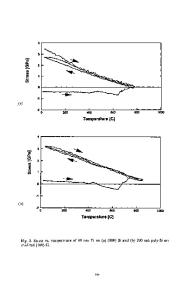Formation and Stability of NI(PT) Silicide on (100)SI and (111)SI
- PDF / 1,083,729 Bytes
- 6 Pages / 417.6 x 639 pts Page_size
- 13 Downloads / 296 Views
*Institute of Materials Research and Engineering, Blk S7, level 3, National University of Singapore, Singapore 119260, e-mail: [email protected] "**Department of Electrical Engineering, National University of Singapore, Singapore 119260. ***Department of Physics, National University of Singapore, Singapore 119260.
ABSTRACT The effect of a small amount of Pt (5 at.%) on the thermal stability of NiSi film on (100)Si and (111 )Si has been investigated. Rutherford back scattering, Scanning Electron Microscopy, and X-ray diffraction have been used to study the formation, microstructure and orientation of the silicide. The addition of platinum results in increasing the disilicide nucleation temperature to 9000 C and thus leads to a better stability of NiSi at high IC processing temperatures. The presence of Pt also induced a texture of the NiSi film both on (11 1)Si and (100)Si. The increase in thermal stability is explained in terms of nucleation controlled reaction concept and should open new possibilities for the use of NiSi in self aligned silicidation. The redistribution of Pt in the silicide is examined and explained in terms of kinetics and thermodynamics considerations. The addition of Pt also increases the temperature of agglomeration of NiSi. INTRODUCTION Self-aligned-silicidation (salicidation) is widely used in integrated circuits to reduce polysilicon interconnect resistance and source/drain contact resistance. Currently TiSi 2 is used for salicidation, but the formation of its low resistivity phase is dependent on the linewidth leading to an increase in sheet resistance for gate lines narrower than 0.5 jm'. CoSi 2 has been introduced to overcome these problems. However, severe junction leakage, a relatively large consumption of Si and the difficulty in producing uniform layers seem to be the limiting factors
for the application of this silicide to ultra-shallow junctions. Recently, it has been demonstrated 2 that nickel monosilicide is potentially a suitable candidate for deep sub-micron CMOS devices, because its sheet resistance remains unchanged even for linewidths down to 0.1 jim. In addition, the consumption of Si is also relatively low during the formation of NiSi. However, the transformation of NiSi into the high resistivity disilicide (NiSi 2) and the agglomeration of NiSi at elevated temperatures are concerns for salicidation. In this report, the effects of small amount of Pt on the stability and microstructure of NiSi films are presented. EXPERIMENT Pure Ni films and Ni(Pt) films with thickness ranging from 20 to 50 nm were evaporated by sputtering of pure Ni and Ni(Pt) alloy target on (100)Si and (11 1)Si wafers. The wafers were cleaned by chemical etching. The concentration of Pt in the Ni(Pt) films measured by Rutherford back scattering (RBS) was equal to 5 at.%. Annealing of one-minute duration were performed by rapid thermal processing (RTP) under N 2 atmosphere at temperatures ranging from 500 to 900'C. The three types of samples (Ni/(100)Si, Ni(Pt)/(100)Si, and Ni(Pt)/(1 I1)Si) were a
Data Loading...








